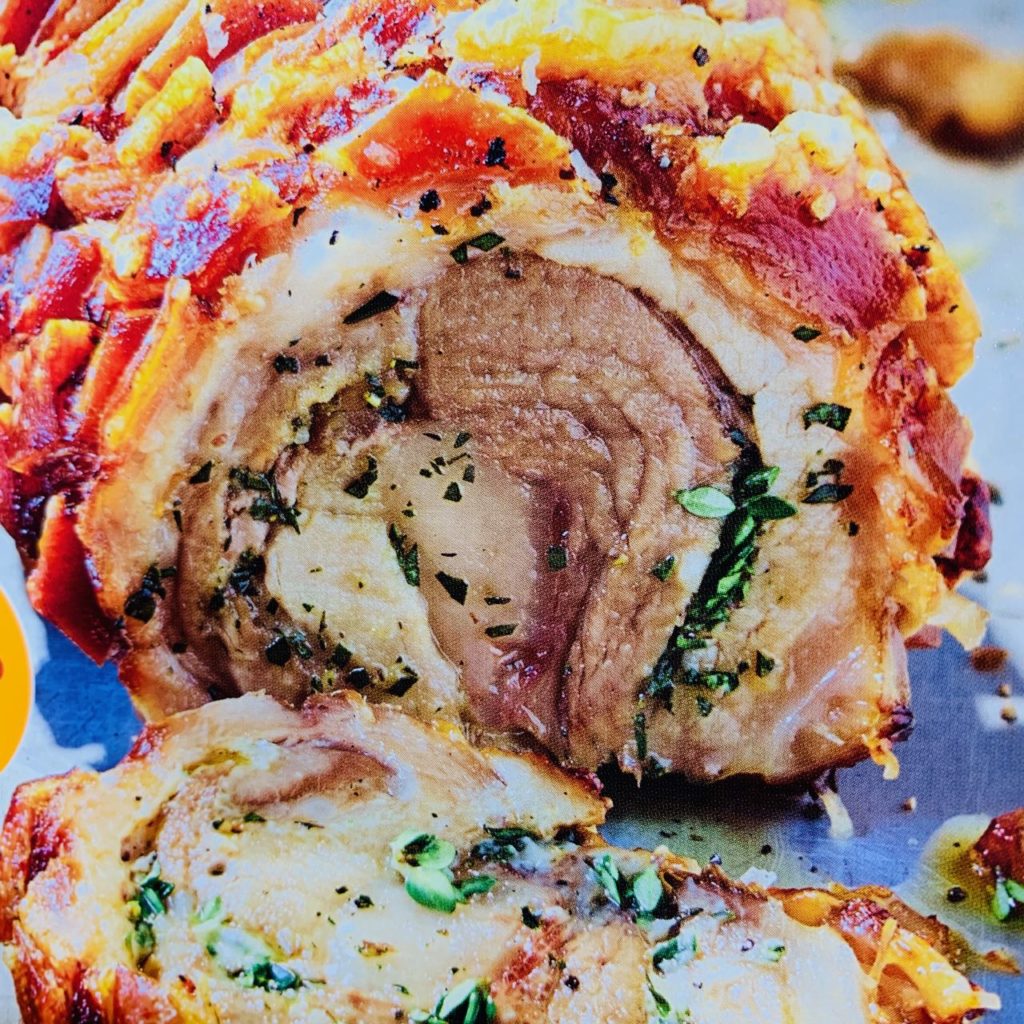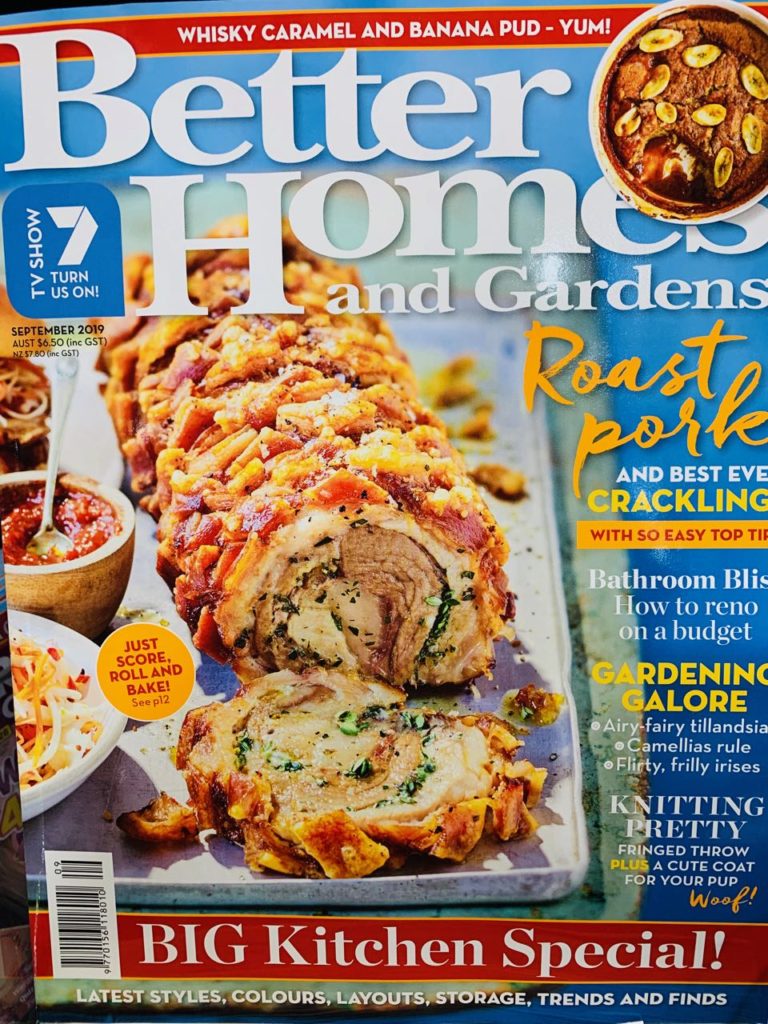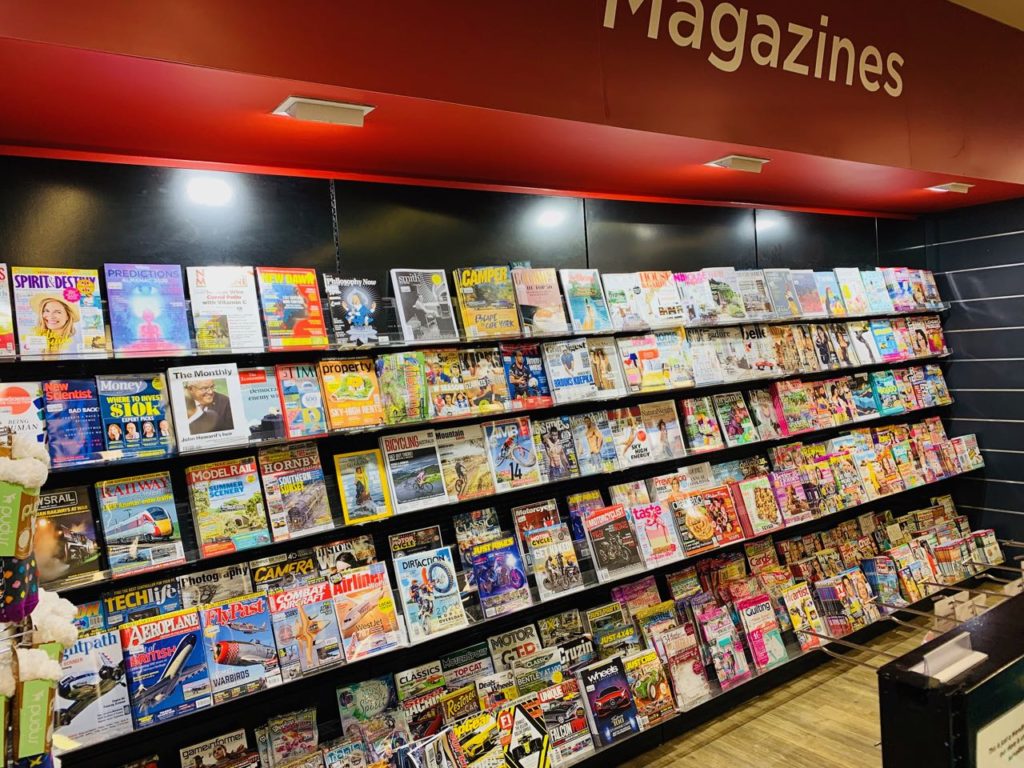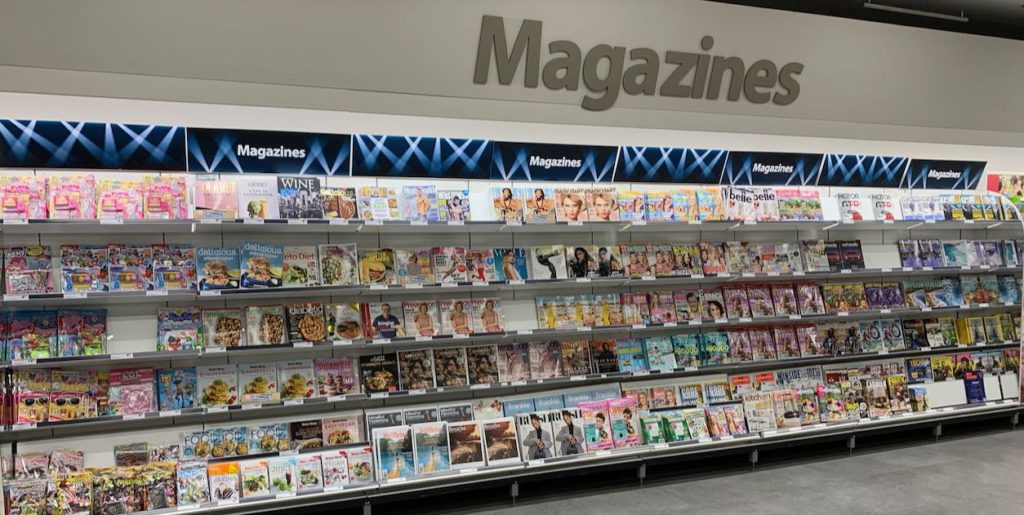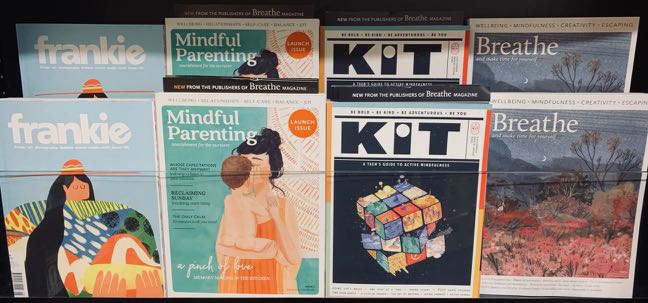Bauer looking at Pacific Magazines?
Rumour that Bauer could consider acquiring Pacific Magazines has been circulating for some time inside publishing and connected circles has been given oxygen today This from B&T:
According to reports in today’s The Australian, Seven is negotiating with rival Bauer Magazines to offload its Pac Mag business.
Pacific Magazines currently publish titles such as Better Home And Gardens, marie claire, Who, New Idea and Men’s and Women’s Health.
According to Seven’s annual report, Pac Magazines generated revenue of just shy of $130 million for the financial year, down 7.2 per cent from $139.5 million the previous year.
The reverse had been a rumour through late 2017 / early 2018. However, with the latest results from Seven, and a new CEO working on the business, being a seller makes more sense.
If such an acquisition did proceed, there would be implications for all businesses in the magazine supply chain.
For several years, when asked at conferences and when participating in industry panels, if I have been asked I have said that Australia is too small for both Bauer and Pacific, especially with the weekly titles.
Is the cover price of individual weekly magazines redundant?
 The bagging / bundling of magazines started in the UK years ago. Then, it came to Australia.
The bagging / bundling of magazines started in the UK years ago. Then, it came to Australia.
In London over the last couple of days I’ve seen bundled offers easily available, begging the question: Is the cover price of individual weekly magazines redundant?
This bagged pack in the photo offers four titles for £2.95. My understanding is that in this bundle, OK! is the hero product, the one on which the bundle price will be judged. We see similar moves in Australia with the hero product leading the bundle.
With magazine sales continuing to be challenged, I suspect we will see more bundling and less reliance for individual cover price.
The magazine wall in the newsagency
This magazine wall we have in one of my shops remains an important part of the business. While it is on a black wall, it can be seen from outside the shop, in the mall. The range works for us and only rarely are we asked for titles we do not stock. It is a busy part of the business, one we will maintain.
I mention this as I am regularly asked about plans for magazines in my own businesses.
This next photo is from the Woolworths George Street Sydney store. It’s upstairs, on level 1. I visit it every time I am in Sydney, usually every couple of weeks. What Wass once a busy section ra4rely has shoppers when I visit.
Their range is not as deep. It does not have the specialisation you can find in most newsagencies.
I think specialty titles are more important to our channel now than the weeklies and major Aussie monthlies. While these titles do matter, it is the niche titles our competitors do not carry that will keep shoppers shopping with us.
Tips for driving crossword sales in the newsagency
The crossword segment of magazines continues to perform well in retail newsagencies. I see plenty of businesses reporting growth and those reporting decline report a lower decline for crosswords.
Crosswords respond well to in-store engagement and promotion. For a small investment of time, you can expect a lift in sales of crossword titles. Here is my current list of top engagement opportunities for a retailer with crosswords:
- If you have a table where shoppers can sit for a while, open a crossword and placing some pens nearby so people can engage and complete a crossword together.
- If you don’t have a table, set one up as this is an easy way to boost sales.
- Move the entire crossword segment next to weeklies. Every time we have seen this done there is a terrific sales jump.
- Also place crossword titles with their parent brand: Better Homes and Gardens and Australian Women’s Weekly, for example. This could be done as co-location – in addition to regular placement. I say also as this should be a secondary placement.
- Call out a crossword title as a staff member fave and note why with a small sign in front. This type of personal recommendation works well in book retailing.
- In front of top selling weeklies, place a plastic or acrylic pocket with A5 titles from the same brand as both titles are bought by the same shopper.
- Pitch a crossword or two at the counter.
- Consider a crossword themed window.
- Consider a crossword lovers event. It could be a simple afternoon team with the idea of them meeting each other and sharing stories. Your focus could be to thank them for their love of crosswords.
- Trial placing your most popular two crosswords next to daily newspapers. Count how many you place so that you can measure the success.
- Run a loyalty program for magazines. Crossword shoppers will appreciate this and drive more whole of business shopping as a result.
- Shine a light on your range on social media – let locals know that your business is the local destination from crosswords.
I get that some reading this will say we only get 25%, why bother. I agree the margin is disrespectful. However, crossword shoppers purchase out of habit. That makes them valuable to us beyond the crossword purchase.
7-Eleven agrees to no longer stock ‘porn’ magazines
Following lobbying facilitated by collective shout, 7-Eleven Australia has declared that the target ‘porn’ magazines no longer be stocked in their stores. There is no information about the specific titles being removed.
AFL Footy record a profitable business
Mediaweek yesterday had the story about the results of Pacific Star Network, the sports radio and media business with Craig Hutchison as CEO.
Pacific Star Network reports Crocmedia financials for 2018-19
FY19 revenue of $67.0 million was up 140% and underlying EBITDA of $9.0 million (guidance: $8.75-9.25 million) was up 208% on the prior corresponding period (pcp), respectively.
In the story is a report abut the purchase of the AFL Record business from the AFL.
In July 2018, PNW’s wholly owned subsidiary Crocmedia signed an agreement with the AFL to acquire the AFL Publishing business. The business is responsible for numerous football related publications, including the iconic AFL Record publication, which has been the official match program for more than 100 years.
The AFL Publications business had a purchase price of $8.1 million comprising $5.850 million cash less working capital adjustments of $0.244 million and $2.250 million prepaid advertising to be retained by the AFL. The AFL Record performance was in line with expectations, with revenue of $6.846 million and net profit after tax at $2.269 million.
That is a net profit 33.14%, an extraordinary result.
Now, while most of these publications are not sold in newsagencies, the report does indicate the value that can be achieve from a niche publication with an efficient distribution network.
Magazine sales trials boost sales
It is terrific seeing magazine publishers trying different approaches to boost sales. I am aware of five different title-specific trials being run right now in selected newsagencies. Each is designed to achieve incremental purchases of the target title in the participating store. Each trial is being run in between 5 and 10 newsagencies.
I like the trials as they will provide experience and data soon which decisions can be made. I also like that the trans are different to what we have seen in the past for magazine promotions.
Promoting a raunch title available in some UK newsagents
I noticed this tweet today promoting an R rated title that is available in the UK. Most Australian newsagents I know got out of adult titles years ago.
Out Now!!! Club DVD 12.7 featuring Beth & @Jasmineewebb & Rahyndee & Tiffany James from https://t.co/90sV2b1sB9 ! Available from most newsagents or garages Today !! pic.twitter.com/68tpRN34cL
— Paul Raymond Publications (PRP) (@paulraymondmag) August 22, 2019
Leveraging mindfulness in the newsagency
We have given the expanded range of mindfulness magazine titles better positioning and less noise nearby, to make the most of growing interest in this topic.
This move, which we made on the weekend, was a no-brainer given the increase in sales of mindfulness related products. The move also lends itself to social media support, to pitch to folks in the area who may want to check out these titles.
While, for sure, the low margin on magazines is frustrating, a move like this we have done for mindfulness required minimal time and no capital. It’s a small-step reminder that we are relevant magazine specialists, even if our range is less today than a year ago.
What is this WHAT DOCTORS DON’T TELL YOU title?
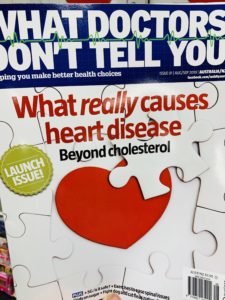 I noticed WHAT DOCTORS DON’T TELL YOU on the shelves of a shop this week. Having never seen the title before, I took a look. I found it hard to believe the veracity of claims I saw in a quick scan of articles. It feels like this title is targeted at people drawn to pseudo-medicine / quackery.
I noticed WHAT DOCTORS DON’T TELL YOU on the shelves of a shop this week. Having never seen the title before, I took a look. I found it hard to believe the veracity of claims I saw in a quick scan of articles. It feels like this title is targeted at people drawn to pseudo-medicine / quackery.
What is pitched as a launch issue is an Aussie version of a UK title that has been around for years. Checking online, I can find references as far back as 2012.
There is controversy about this magazine. Dr Margaret McCartney published comments in October 2012 including:
Although medical journals carry advertisements for drugs, the ones in this magazine are an extraordinary shrine to non-evidenced based medicine. …
It is right to criticise medicine, but the same standards must be applied to all interventions, “alternative” or not. We now realise how important it is to ensure that fair evidence, free of bias, is used in making medical decisions. There is no point in substituting bad medicine for bad science, and it is not clear from this magazine where the hierarchies of evidence stand, and the limitations and uncertainties that arise in research are not consistently explained. The magazine’s liability statement—“the publishers cannot accept any responsibility for any damage or harm caused by any treatment, advice or information contained in this publication”—should perhaps be better printed on the cover, in an unmissable font.”
This article by Christine Oka, Research & Instruction, Northeastern University Libraries, Boston, MA, at the ProQuest blog from 2017, is fascinating:
Looking into the background of WDDTY I saw it was originally launched as an alternative medicine magazine in the UK, in 2012 with a number of cautionary reviews from medical and health publications, such as the British Medical Journal, Health News Review, and the Science and Skepticism section of The Guardian. WDDTY is published monthly and contains advertisements from the holistic and alternative medicine market. The WDDTY Editorial Panel is comprised of “some of the world’s leading pioneers in nutritional, environmental and alternative medicine.” But another source writes about The Editorial Panel, “Of those who can be found on the GMC List of Registered Medical Practitioners, one has been issued with a warning, one has relinquished his registration, and all of them advocate dubious interventions, some of which have been shown to do more harm than good.”
I checked out What doctors don’t tell you because it looked dodgy. Checking online, plenty think that.
While we are not censors, it is useful to know about titles available for our shelves, so our stocking decisions can be informed.
Big W quitting magazines is good for newsagents
I first heard about Big W planning on quitting magazines earlier this year. It was good news but I wanted to see it happen before commenting.
Now, newsagents near Big W stores are telling me they are seeing a bump in magazine sales. This is good news.
The decision by the group to quit magazines is another in a series of decisions as they recalibrate their business. The magazine category is not the only one to see significant change. However, it is the category that directly affects our channel.
If your newsagency has a Big W nearby, now would be a good time to pitch magazines, especially the depth of your range, to attract people who may have shopped at Big W and not at your store for magazines. If you run a loyalty program, promote that too as it could entice the Big W shopper to engage with you.
Newsagents were in magazines long before Big W and we are still win the category after they quit. This is a good message for small business retail.
Good result for Bauer
From Mediaweek (referencing a story at The Australian, which is behind a pay wall):
Bauer back in black: Cost-cutting key to magazines making a profit
That compares to a net loss of $11.3m in 2017.
Bauer’s editorial expenses dropped to $58m last year, from $72.6m in 2017, with marketing and ad expenses falling to $46.4m, from $54m. Its administration expenses fell to $45.6m, from $55.3m.
Of the group’s $224.3m of revenue, about $142.1m came from the sale of magazines and $48.8m from advertising.
Mad magazine to end regular publication
Mad magazine is ceasing regular print issues. This is sad news. It’s a magazine I have enjoyed regularly for decades. It has taught generations about satire. It has been a good title to mix it with sarcasm products. Al Feldstein, the genius behind the magazine, passed away five years ago.
Magazines. Keeping newsagents unique.
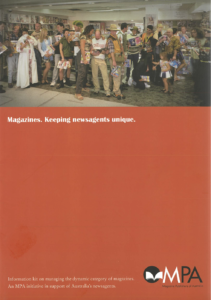 Click here to see Magazines. Keeping newsagents unique. a terrific guide published by the MPA, Magazine Publishers of Australia, in June 2003.
Click here to see Magazines. Keeping newsagents unique. a terrific guide published by the MPA, Magazine Publishers of Australia, in June 2003.
As you will see in throughout this document, the MPA offered comprehensive advice on magazine range, display, promotion and management, advice that was ideal for that time.
My first every magazine relay in-store flowed from this MPA work.
While magazines play a lesser role today in terms of foot traffic and financially, I see value in a similar supplier driven document that draws on shopper and other data, to help newsagents what remains an important category.
New magazine launch targets valuable core shopper demo
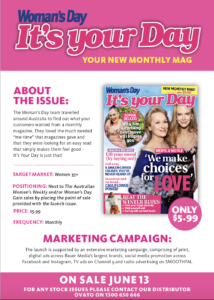 The launch tomorrow of It’s Your Day by Bauer Media is important for newsagents as this new title targets a demographic that is key to our channel – women 35+. This is the demo that spends the most on cards, visits most often and connects best with the newsagency channel.
The launch tomorrow of It’s Your Day by Bauer Media is important for newsagents as this new title targets a demographic that is key to our channel – women 35+. This is the demo that spends the most on cards, visits most often and connects best with the newsagency channel.
The launch of It’s Your Day by Bauer provides us with an opportunity to re-up our pitch to this high-value newsagency shopper, to deepen the connection and leverage the launch activity.
The marketing around the new title launch offers us an opportunity to pitch our local businesses and to do this in a way that separates us from supermarkets and others. For them, this title will be another SKU whereas for us it feels at home with our core customer.
Engaged card companies will be especially happy about this new title. I hope they take the time too understand that target reader for It’s Your Day is the target shopper top off mind for the card companies, and their retailers.
We don’t see many magazine launches from major publishers. This launch is important, a valuable investment in print. In some respects, how it goes in our channel is up to us.
Australia’s tough magazine market
New Bauer CEO, Brendan Hill visiting Bauer Media Group COO Veit Dengler spoke with Hannah Blackiston for Mumbrella. Here are some quotes that may interest…
“We’ve made no secret of the fact that we’re going to keep growing our audiences and we also believe the data that will come out of it that will put us in good stead for the future. The business has been transitioning for sometime and globally we’re getting very serious about these different revenue streams and different areas for the business to grow,” says Hill.
…
“I think if you look worldwide you will certainly see that some magazine publishers have disappeared or been acquired, that is a trend. But three is actually not that many players, in most big markets around the world there are more publishers than that. So I would say it’s actually already a fairly consolidated market,” says Dengler.
…
“Media is always changing, as anyone in this game can tell you, but that’s the fun. That’s why we are into it, that’s why passionate people work in our industry. There are absolutely going to be changes, do we know exactly how the business will continue? No. But many big publishing houses are doing this globally, changing plans, acquiring, launching, closing. It’s the nature of media.
“So yeah, there will also be change. But we’re really excited for the core portfolio we have now and there’s a real focus on the executive team who are very strong and a good group of people in terms of innovation and looking at the business a different way,” says Hill.
…
“I think Australia is probably one of the toughest markets for magazines worldwide. I think the advertising decline was faster and earlier than elsewhere. And if you look at the share of advertising dollars that go to magazines of the whole advertising pie it’s one of the lowest in the developed economies. And because of your geography, distribution costs are very high compared to other markets.”
Just as magazine publishers are confronted by challenges of change and lean into them, so should we.
Advice on how you could grow crossword sales in your newsagency
Crossword sales are strong in Australia. The segment is performing well, delivering year on year growth for many newsagency businesses. It is the magazine segment that offers the best opportunity for growth based on my experience in-store and broader channel data analysis.
The crossword category is the easiest category in which to grow sales. Here are some ideas with which you can engage to achieve this.
- Move the entire crossword segment next to weeklies. Every time I have seen this done there is a measurable sales jump.
- Place crossword titles with their parent brand: Better Homes and Gardens and Australian Women’s Weekly, for example. This could be done as co-location – in addition to regular placement.
- Call out a crossword title as a staff member fave and note why with a small sign in front. This type of personal recommendation works well in book retailing.
- In front of Take 5 and That’s Life, place a plastic or acrylic pocket with A5 titles from the same brand as both titles are bought by the same shopper.
- Pitch a crossword or two at the counter.
- Pitch crosswords with jigsaws – they are often the same shopper.
- Consider a crossword themed front window.
- Consider a crossword lovers event. It could be a simple afternoon team with the idea of them meeting each other and sharing stories. Your focus could be to thank them for their love of crosswords.
- Trial placing your most popular two crosswords next to daily newspapers. Count how many you place so that you can measure the success.
- Run a loyalty program for magazines. Crossword shoppers will appreciate this and drive more whole of business shopping as a result.
- If you have a table where shoppers can sit for a while, consider opening a crossword and placing some pens nearby so people can engage.
- Shine a light on your range on social media – let locals know that your business is the local destination from crosswords.
Why do this given that you only make 25% from crossword titles? Because crossword shoppers are loyal. The better you serve them and the more you appreciate them the more return business you will achieve.
When a newsagent receives details of a Woolworths exclusive offer
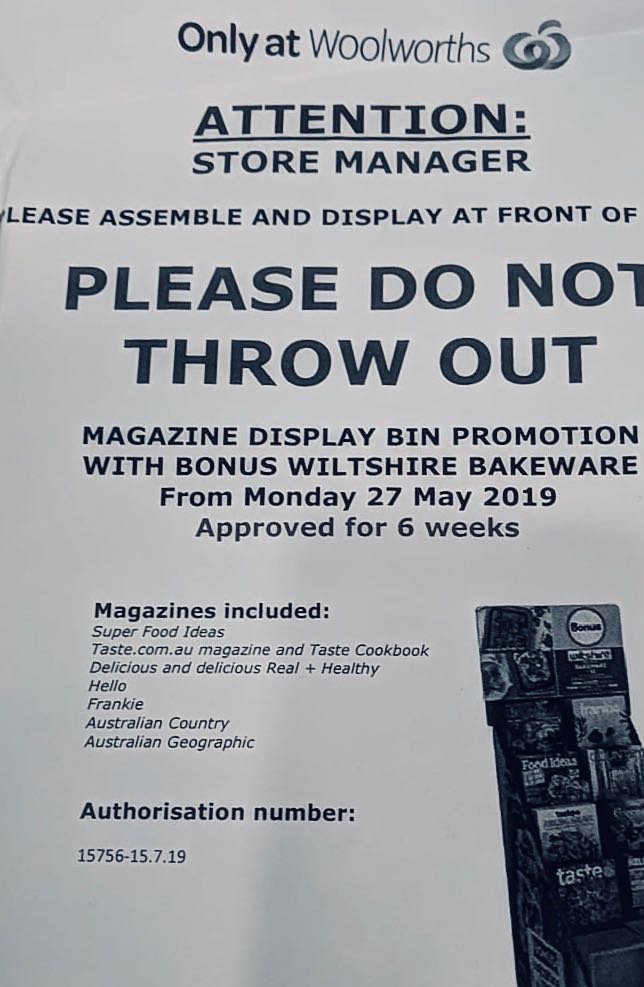 I get that publishers need to make channel specific pitches. And, I get that supermarkets offer far more discipline that newsagents.
I get that publishers need to make channel specific pitches. And, I get that supermarkets offer far more discipline that newsagents.
What I do not get is that publishers pay supermarkets for discipline while they pay our channel nothing. I am confident Woolworths is receiving a fee, in one for or another, for this six week exclusive promotion.
Space is everything to supermarkets. I have been told previously of how they monetise aisle ends, counter positions and other high traffic positions.
Imagine the discipline magazine publishers could garner from our channel if they financially respected us as they do the supermarkets. While there will be excuses, no has seriously tested this. I suspect, however, that it is too late to test it.
To be fair to magazine publishers, I am aware of newsagent exclusive deals being early returned the day of on sale, deals that subsequently sold out in less than a week. I am also aware of exclusive to newsagent floor units with a valuable gift with purchase not being put on the shop floor.
Publishers notice these things. Discipline matters to them if they are running an integrated campaign.
Put the current issue of Mindfood on the counter
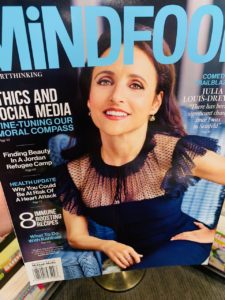 The current issue of Mindfood magazine, with Julia Louis-Dreyfus on the cover is worth pitching at the counter. With her acclaimed, funny, insightful and searing VEEP TV series coming to an end, this star is in the news. VEEP has done well in Australia. I think Julia being on the cover could be enough to age people who would not usually buy the title to at least consider it.
The current issue of Mindfood magazine, with Julia Louis-Dreyfus on the cover is worth pitching at the counter. With her acclaimed, funny, insightful and searing VEEP TV series coming to an end, this star is in the news. VEEP has done well in Australia. I think Julia being on the cover could be enough to age people who would not usually buy the title to at least consider it.
Do we need to see old magazine titles retired?
In the online world of e-commerce sites, information sited, podcasts and community forums, it is common to see major rebrands and replacements of old with new.
Fresh is in online. Thanks to excellent and deep engagement data, decisions are made based on evidence. hence the replacement of brands with new.
Looking at the magazine shelves, I think we could do with a bit of this. There are some tired titles that are not viable for newsagents at a GP of 25% of cover price that is not keeping up with CPI.
Newsagents think about these things when looking at space allocation for the category.
Is Woolworths getting out of magazines?
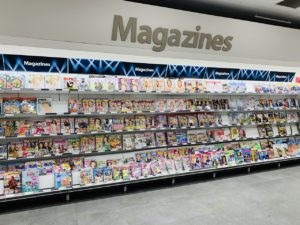 A couple of people mentioned to me they heard a rumour Woolworths was getting out of magazines. I checked several Woolworths stores, including George St Sydney, and while their magazine offer is patchy (at best) there is no evidence of them exiting yet.
A couple of people mentioned to me they heard a rumour Woolworths was getting out of magazines. I checked several Woolworths stores, including George St Sydney, and while their magazine offer is patchy (at best) there is no evidence of them exiting yet.
What does appear to be the case in Coles and Woolworths is a reduction in magazine pockets at or near registers. This location was high value of impulse purchases of magazines. The retreat from the large number of pockets that used to be at registers must have impacted magazine sales in supermarkets.
I suspect supermarkets will be a space to watch in terms of magazines over the rest of 2019.
Pitch the new look BHG
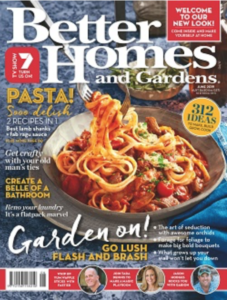 The refreshed look for Better Homes and Gardens is a good reason to place the latest issue out today at the counter and with newspapers, as well as in the usual location. There is excellent TV coverage for the issue so support in-store should work.
The refreshed look for Better Homes and Gardens is a good reason to place the latest issue out today at the counter and with newspapers, as well as in the usual location. There is excellent TV coverage for the issue so support in-store should work.
Supermarkets are not likely to do anything special.
Historically, BHG responds well to in-store tactical placement support.
Magazine location in-store
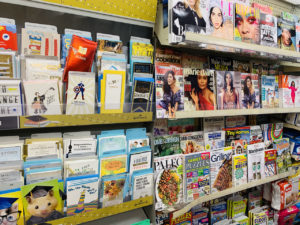 In US drugstores, larger format c-stores, more and more we see magazines located next to greeting cards. I have seen this in stores with a small range of cards and magazines as well as a larger range, where the two departments are next to each other.
In US drugstores, larger format c-stores, more and more we see magazines located next to greeting cards. I have seen this in stores with a small range of cards and magazines as well as a larger range, where the two departments are next to each other.
This departmental adjacency is different to how the stores were laid out a few years ago.
I wonder if they have data that suggest commercial value from location next to each other.
While people enter these drugstores for reasons that are different to people shopping an Australian newsagency, the location of departments is something that should be regularly on our minds.
I think too many businesses incur channel have a sent and forget approach to department location in-store. Shoppers become store blind.
Changing the location of a department will usually frustrate some shoppers. It will also, usually, boost sales.
